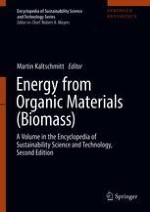2019 | OriginalPaper | Buchkapitel
Biogas Substrates from Municipalities and Industries
verfasst von : Ulrike Seyfert, Daniela Thrän, Jasmin Kalcher
Erschienen in: Energy from Organic Materials (Biomass)
Verlag: Springer New York
Aktivieren Sie unsere intelligente Suche, um passende Fachinhalte oder Patente zu finden.
Wählen Sie Textabschnitte aus um mit Künstlicher Intelligenz passenden Patente zu finden. powered by
Markieren Sie Textabschnitte, um KI-gestützt weitere passende Inhalte zu finden. powered by
